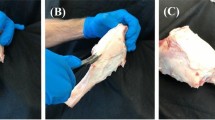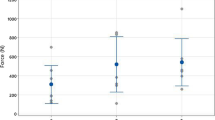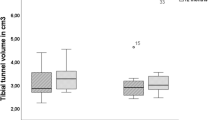Abstract
Introduction
Serial dilation of the bone tunnel has been reported to create a tighter graft-tunnel fit. It was hypothesized that a serial dilation of the femoral bone tunnel would increase the initial fixation strength in press-fit anterior cruciate ligament (ACL) reconstructive surgery.
Materials and methods
Initial fixation strength of the femoral press-fit fixation technique was investigated in 72 porcine specimens in an ex vivo study by varying the femoral tunnel preparation technique. Extraction-drilling, tunnel dilation by 1 mm and dilation by 2.5 mm were assessed. Initial fixation strength of press-fit fixated patellar tendon–bone grafts was tested within each preparation group conducting a single cycle (and cyclic) load to failure protocol. The resulting tunnel diameter and the porcine femoral bone mineral density were determined using microradiographs and peripheral quantitative CT scans, respectively.
Results
Dilating a previously extraction-drilled femoral bone tunnel by 1 mm significantly enhances initial press-fit fixation strength in both single cycle and cyclic load to failure testing when compared to extraction-drilling and tunnel dilation by 2.5 mm. Due to an initial spring-back effect the resulting diameter of the femoral tunnel was underestimated by 3.3% with drilling and 6.7 and 12.2% with dilation by 1 and 2.5 mm, respectively. Volumetric trabecular bone mineral density at the site corresponding to the area of tunnel placement averaged 318 mg/cm³.
Conclusion
Dilating a femoral tunnel that is underdrilled by 1 mm appears to be a reasonable technical procedure in order to enhance initial fixation strength of press-fit ACL graft fixation.



Similar content being viewed by others
References
Aerssens J, Boonen S, Lowet G, Dequeker J (1998) Interspecies differences in bone composition, density and quality: potential implications for in vivo bone research. Endocrinology 139:663–670
Boszotta H (1997) Arthroskopische femorale Press-fit-Fixation des Lig.-patellae-Transplantats beim Ersatz des vorderen Kreuzbands. Arthroskopie 10:126–132
Brand JC, Pienkowski D, Steenlage E, Hamilton D, Johnson DL, Caborn DN (2000) Interference screw fixation strength of a quadrupled hamstring tendon graft is directly related to bone mineral density and insertion torque. Am J Sports Med 28:705–710
Caborn DNM, Urband WP, Johnson DL, Nyland J, Pienkowski D (1997) Biomechanical comparison between BioScrew and titanium alloy interference screws for bone-patellar tendon-bone graft fixation in anterior cruciate ligament reconstruction. Arthroscopy 13:229–232
Dargel J, Schmidt-Wiethoff R, Schmidt J, Koebke J (2005) Histomorphology and microradiography of quadriceps tendon-patellar bone grafts in press-fit anterior cruciate ligament reconstruction. J Orthop Res 23:1206–1210
Dargel J, Schmidt-Wiethoff R, Schneider T, Brüggemann P, Koebke J (2006) Biomechanical testing of quadriceps tendon-patellar bone grafts: an alternative graft source for press-fit anterior cruciate ligament reconstruction? Arch Orthop Trauma Surg 126:265–270
Hertel P (1997) Technik der offenen Ersatzplastik des vorderen Kreuzbandes mit autologer Patellarsehne. Arthroskopie 10:240–245
Hertel P, Behrend H, Cierpinski T, Musahl V, Widjaja G (2005) ACL reconstruction using bone-patellar tenodon-bone press-fit fixation: 10-year clinical results. Knee Surg Sports Traumatol Arthrosc 13:248–255
Fu FH, Bennett CH, Ma CB, Menetrey J, Lattermann C (2000) Current trends in anterior cruciate ligament reconstruction. Part II: operative procedures and clinical correlations. Am J Sports Med 28:124–130
Järvinen TLN, Nurmi JT, Sievänen H (2004) Bone density and insertion torque as predictors of anterior cruciate ligament graft fixation strength. Am J Sports Med 32:1421–1429
Johnson LL, van Dyk GE (1996) Metal and biodegradable interference screws: comparison of failure strength. Arthroscopy 12:452–456
Kold S, Rahbek O, Toft M, Ding M, Overgaard S, Soballe K (2005) Bone compaction enhances implant fixation in a canine gap model. J Orthop Res 23:824–30
Lee MC, Jo H, Bae TS, Jang JD, Seong SC (2003) Analysis of initial fixation strength of press-fit fixation technique in anterior cruciate ligament reconstruction. Knee Surg Sports Traumatol Arthrosc 11:91–98
Malek MM, DeLuca JV, Verch DL (1994) Arthroscopically assisted anterior cruciate ligament reconstruction using central third patellar tendon autograft with press-fit femoral fixation. In: Parisien JS (ed) Current techniques in arthroscopy. Current Medicine, Philadelphia, pp 159–166
Malek MM, DeLuca JV, Verch DL, Kunkle KL (1996) Arthroscopically assisted ACL reconstruction using central third patellar tendon autograft with press-fit femoral fixation. Instr Course Lect 45:287–295
Mattews LS, Lawrence SJ, Yahiro MA, Sinclair MR (1993) Fixation strength of patellar tendon-bone grafts. Arthroscopy 9:76–81
Musahl V, Abramowitch SD, Gabriel NT, Debski RE, Hertel P, Fu FH, Woo SL (2003) Tensile properties of an anterior cruciate ligament graft after bone-patellar tendon-bone press-fit fixation. Knee Surg Sports Traumatol Arthrosc 11:68–74
Nakabayashi Y, Wevers HW, Cooke TD, Griffin M (1994) Bone strength and histomorphometry of the distal femur. J Arthroplasty 9:307–315
Nurmi JT, Järvinen TLN, Kannus P, Sievanen H, Toukosalo J, Jarvinen M (2002) Compaction versus extraction drilling for fixation of the hamstring tendon graft in anterior cruciate ligament reconstruction. Am J Sports Med 30:167–173
Nurmi JT, Kannus P, Sievänen H, Jarvinen M, Jarvinen TL (2003) Compaction drilling does not increase the initial fixation strength of the hamstring tendon graft in anterior cruciate ligament reconstruction in a cadaver model. Am J Sports Med 31:353–358
Nurmi JT, Kannus P, Sievänen H, Jarvela T, Jarvinen M, Jarvinen TL (2004a) Interference screw fixation of soft tissue grafts in anterior cruciate ligament reconstruction: Part 1: effect of tunnel compaction by serial dilators versus extraction drilling on the initial fixation strength. Am J Sports Med 32:411–417
Nurmi JT, Sievänen H, Kannus P, Jarvinen M, Jarvinen TL (2004b) Porcine tibia is a poor substitute for human cadaver tibia for evaluating interference screw fixation. Am J Sports Med 32:765–771
Paschal SO, Seemann MD, Ashman RB, Allard RN, Montgomery JB (1994) Interference fixation versus postfix fixation of bone-patellar tendon bone grafts for anterior cruciate ligament reconstruction: a biomechanical comparative study in porcine knees. Clin Orthop 300:281–287
Pavlik A, Hidas P, Tállay A, Toman J, Berkes I (2006) Femoral press-fit fixation technique in anterior cruciate ligament reconstruction using bone-patellar tendon-bone grafts. Am J Sports Med 34:220–225
Pena LL, Gröntvedt T, Brown GA, Aune AK, Engebretsen L (1996) Comparison of failure strength between metallic and absorbable interference screws. Influence of insertion torque, tunnel-bone block gap, bone mineral density, and interference. Am J Sports Med 24:329–334
Rittmeister ME, Noble PC, Bocell JR, Alexander JW, Conditt MA, Kohl HW (2001) Interactive effects of tunnel dilation on the mechanical properties of hamstring grafts fixed in the tibia with interference screws. Knee Surg Sports Traumatol Arthrosc 9:267–271
Rupp S, Krauss PW, Fritsch EW (1997) Fixation strength of a bioabsorbable interference screw and press-fit technique in anterior cruciate ligament reconstruction with a BPTB graft. Arthroscopy 13:61–65
Seil R, Rupp S, Krauss PW, Benz A, Kohn DM (1998) Comparison of initial fixation strength between biodegradable and metallic interference screws and a press-fit fixation technique in a porcine model. Am J Sports Med 26:815–819
Schmidt-Wiethoff R, Dargel J, Gerstner M, Schneider T, Koebke J (2006) Bone plug length and loading angle determine the primary stability of patellar tendon-bone grafts in press-fit ACL reconstruction. Knee Surg Sports Traumatol Arthrosc 14:108–111
Sievänen H, Koskue V, Rauhio A, Kannus P, Heinonen A, Vuori I (1998) Peripheral quantitative computed tomography in human long bones: evaluation of in vitro and in vivo precision. J Bone Miner Res 13:817–882
Author information
Authors and Affiliations
Corresponding author
Rights and permissions
About this article
Cite this article
Dargel, J., Schmidt-Wiethoff, R., Brüggemann, GP. et al. The effect of bone tunnel dilation versus extraction drilling on the initial fixation strength of press-fit anterior cruciate ligament reconstruction. Arch Orthop Trauma Surg 127, 801–807 (2007). https://doi.org/10.1007/s00402-006-0206-6
Received:
Published:
Issue Date:
DOI: https://doi.org/10.1007/s00402-006-0206-6




